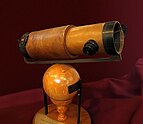Overview of the events of 1672 in science
| |||
|---|---|---|---|
| +... |
| 1672 in science |
|---|
| 16711673 |
| Fields |
| Technology |
| Social sciences |
| Paleontology |
| Extraterrestrial environment |
| Terrestrial environment |
| Other/related |

The year 1672 in science and technology involved some significant events.
Astronomy
- February 6 – Isaac Newton submits his first paper on optics to the Royal Society of London.
- December 23 – Giovanni Cassini discovers Rhea, a satellite of Saturn.
- John Flamsteed determines the solar parallax from observations of Mars.
Botany
- Robert Morison publishes Plantarum Umbelliferarum Distributio Nova, per Tabulas Cognationis et Affinitatis, ex Libra Naturae observata et detecta, the first monograph devoted to a specific group of plants, the Umbelliferae.
Mathematics
- Georg Mohr publishes the Mohr–Mascheroni theorem, that any geometric construction that can be performed by a compass and straightedge can be performed by a compass alone.
Medicine
- Paul Barbette publishes Opera omnia medica et chirurgica.
- Richard Lower publishes De Catarrhis, the first scholarly attempt by an English physician to take a classical doctrine (the theory that nasal catarrh is caused by secretions overspilling from the brain) and to disprove it by scientific experiment.
- Dutch physician Regnier de Graaf describes the female reproductive system.
- Isbrand van Diemerbroeck publishes the first edition of his Anatome corporis humani in Utrecht.
- Thomas Willis publishes the earliest English work on medical psychology, Two Discourses concerning The Soul of Brutes, Which is that of the Vital and Sensitive of Man.
Technology
- Dutch painter Jan van der Heyden improves the fire hose, with his brother Nicolaes, a hydraulic engineer.
Institutions
- January 11 – Isaac Newton is elected a Fellow of the Royal Society of London and it then demonstrates his reflecting telescope to King Charles II of England.
Births
- February 13 – Étienne François Geoffroy, French chemist (died 1731)
- August 2 – Johann Jakob Scheuchzer, Swiss natural historian (died 1733)
- Ann Baynard, English natural philosopher (died 1697)
Deaths
- March – Peter Blondeau, French-born pioneer of mechanised minting of coin
- April 26 – Lionel Lockyer, English quack doctor (born c. 1600)
- July 3 – Francis Willughby, English ornithologist and ichthyologist, pleurisy (born 1635)
- November 19 – John Wilkins, English bishop and natural philosopher, co-founder of the Royal Society (born 1614)
- late – Semyon Dezhnev, Pomor navigator who in 1648 made the first recorded voyage through the Bering Strait (born c. 1605)
References
- "A Letter of Mr. Isaac Newton, Professor of the Mathematicks in the University of Cambridge; Containing His New Theory about Light and Colors: Sent by the Author to the Publisher from Cambridge, Febr. 6. 1671/72; In Order to be Communicated to the R. Society". Philosophical Transactions of the Royal Society. London. 1672-02-19.
The Original or primary colours are, Red, Yellow, Green, Blew, and a Violet-purple, together with Orange, Indico, and an indefinite variety of Intermediate gradations.
- Oliver, Francis Wall (1913). "Robert Morison 1620–1683...". Makers of British Botany. Cambridge University Press. pp. 15–16.
- Mohr, Georg (1672). Euclides Danicus. Amsterdam: Jacob van Velsen.
- Crilly, Tony (2007). 50 Mathematical Ideas you really need to know. London: Quercus. p. 80. ISBN 978-1-84724-008-8.
- De mulierum organis generationi inservientibus tractatus novus: demonstrans tam homines & animalia caetera omnia, quae vivipara dicuntur, haud minus quàm ovipara ab ovo originem ducere.
- "Thomas Willis". Whonamedit?. Retrieved 2011-03-15.
- "Fellowship of the Royal Society 1660-2015". London: Royal Society. 2015. Archived from the original on 2015-10-15.